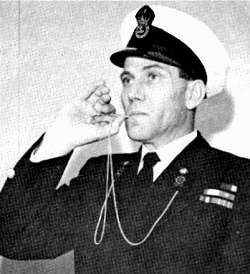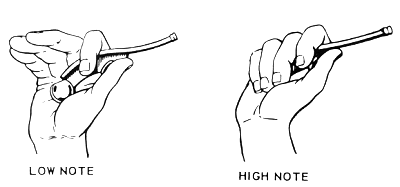Navy Life
The Boatswain's Call

Unique to naval life, are the pipes that are made by the boatswain's call.
Piping is the Naval method of passing orders and every seaman should know how to use a "boatswain's call". The use of the bosun's call goes as far back as the Crusades (1248).
In former days it was worn in English ships as a badge of rank, because it was always used for passing orders. For years it was even worn as a badge of office os the Lord High Admiral of England and his successors up to 1562. Thereafter it was used in the English fleet for passing all orders and since 1671 it became generally known as the "boatswain's call".
Nowadays the boatswain's call and chain are the badge of office of the Chief Boatswain's Mate, the Quartermaster and Boatswain's Mates. The expression "To Pipe" means, to sound on the boatswain's call and the spoken order to qualify it. Some "Pipes" are even orders and do not require any verbal qualification.
The Boatswain's Call

The
boatswain's call is held in the hand between the index finger and
thumb, the latter being on or near the shackle. The side of the
buoy rests against the palm of the hand. The fingers close over
the gun and buoy hole in such a position as to be able to throttle
the exit of air from the buoy to the desired amount. Care must be
taken that the fingers do not touch the edge of the hole in the
buoy, or over the hole in the end of the gun, otherwise all sound
will be completely choked.

Playing the Boatswain's Call
The
bosun's call can be tuned by scraping away and enlarging the wind
edge of the hole
in the buoy and it will sound if the mouth of the gun is held directly
into a moderate wind.
There
are two main notes; the low and the high, and three tones; the plain,
the warble
and the trill.
- Low Note: The low note is produced by blowing steadily into the mouth of the gun with the hole of the buoy unobstructed by the fingers.
- High Note: The high note is produced by throttling the exit of air from the hole of the buoy. This is done by closing the fingers around the buoy, taking care not to touch the edge of the hole or the end of the gun.
- Warble: The warble is produced by repeatedly moving your hand quickly from the high to the low position, which results in a warble similar to that of a canary.
- Trill: The trill is produced by vibrating the tongue while blowing, as in rolling the letter R.
The Pipes
The
following instructions show the various pipes used in the Canadian
Navy. The numbers at the top of each figure represents seconds of
time. The nature, continuity and tone of the notes are indicated
by the various lines, and the degree of their slope indicates the
speed of ascent or descent of the notes.
The Still
 The
still is used to call all hands to attention as a mark of respect,
or to order silence on any occasion. The still is also used to announce
the arrival onboard of a senior Officer. The pipe is an order in
itself and does not require any verbal addition. The still is a
high note held for 8 seconds. If done properly, it should end very
abruptly.
The
still is used to call all hands to attention as a mark of respect,
or to order silence on any occasion. The still is also used to announce
the arrival onboard of a senior Officer. The pipe is an order in
itself and does not require any verbal addition. The still is a
high note held for 8 seconds. If done properly, it should end very
abruptly.
Carry On
 The
carry on is used to negate the still. The pipe is an order in itself
and does not require any verbal addition.
The
carry on is used to negate the still. The pipe is an order in itself
and does not require any verbal addition.
General Call
 The
general call precedes any broadcast order; it draws attention to
the order. The
general call is used when passing out-of-routine orders or information
of general interest.
The
general call precedes any broadcast order; it draws attention to
the order. The
general call is used when passing out-of-routine orders or information
of general interest.
Officer of the Day Call
 The
Officer of the Day call is used to attract the attention of the
Officer of the Day to contact the gangway. The pipe is an order
in itself and does not require verbal addition. The pipe consists
of 4 high "pips".
The
Officer of the Day call is used to attract the attention of the
Officer of the Day to contact the gangway. The pipe is an order
in itself and does not require verbal addition. The pipe consists
of 4 high "pips".
Pipe the Side
 When
a Commanding Officer of an HMC ship arrives onboard he/she is entitled
to this pipe. To be done properly it should be 12 seconds long with
very smooth transitions. To accomplish this, the sailor must take
a very long deep breath prior to beginning; failure to do so will
cause the pipe to be abruptly cut short. The side is also piped
for Royalty, teh Accused when entering a Court Martial and for the
Officer of the Guard (When the Guard is formed up).
When
a Commanding Officer of an HMC ship arrives onboard he/she is entitled
to this pipe. To be done properly it should be 12 seconds long with
very smooth transitions. To accomplish this, the sailor must take
a very long deep breath prior to beginning; failure to do so will
cause the pipe to be abruptly cut short. The side is also piped
for Royalty, teh Accused when entering a Court Martial and for the
Officer of the Guard (When the Guard is formed up).
Hands to Dinner
 The
hands to dinner pipe is made at 1200 when the Ship's Company secures and
commences the mid-day meal, referred to as dinner. It is never made
for any other meal-time. The pipe is an order in itself and does
not require any verbal addition. This pipe is very long and any
is the pride of any sailor that can do it absolutely properly, and
the disgrace of any sailor that does not.
The
hands to dinner pipe is made at 1200 when the Ship's Company secures and
commences the mid-day meal, referred to as dinner. It is never made
for any other meal-time. The pipe is an order in itself and does
not require any verbal addition. This pipe is very long and any
is the pride of any sailor that can do it absolutely properly, and
the disgrace of any sailor that does not.
Pipe Down
 The
pipe down is made at 2230 or at any other time specified by the
routine daily orders, when the Ship's Company retire for the evening
and the silent hours period commences. The pipe is an order in itself
and does not require any verbal addition. When this pipe is made
during the middle of the day, it means that the ship is adopting
a "Sunday Routine for the remainder of the day.
The
pipe down is made at 2230 or at any other time specified by the
routine daily orders, when the Ship's Company retire for the evening
and the silent hours period commences. The pipe is an order in itself
and does not require any verbal addition. When this pipe is made
during the middle of the day, it means that the ship is adopting
a "Sunday Routine for the remainder of the day.
